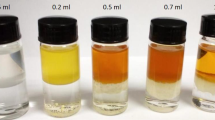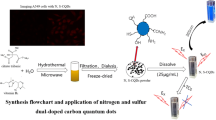Abstract
Non-conjugated polymer carbon dots (PCDs) with a 9% fluorescence quantum yield were synthesized by a pyrolytic method using polyethyleneimine as the sole precursor. The PCDs have an average size about 2.1 nm and a blue fluorescence, with excitation/emission maxima at 380/457 nm, that is quenched by the drug metronidazole. The method has a linear response in the 0.06–15 μg mL−1 metronidazole concentration range and a 20 ng mL−1 detection limit. Milk samples were spiked at two levels (0.6 and 5.0 μg mL−1), and the recoveries of metronidazole are in the range of 96.7–102.2%.

Schematic representation of preparation of non-conjugated polymer carbon dots (PCDs) and detection of metronidazole. Metronidazole with negative charge is easy to produce electrostatic interaction with polyethyleneimine chain with positive charge, which leads to PCDs fluorescence quenching, so as to realize metronidazole detection.





Similar content being viewed by others
References
Zu F, Yan F, Bai Z, Xu J, Wang Y, Huang Y, Zhou X (2017) The quenching of the fluorescence of carbon dots: a review on mechanisms and applications. Microchim Acta 184(7):1899–1914
Ahmed GHG, Laíño RB, Calzón JAG, García MED (2015) Highly fluorescent carbon dots as nanoprobes for sensitive and selective determination of 4-nitrophenol in surface waters. Microchim Acta 182(1):51–59
Xia J, Zhuang YT, Yu YL, Wang JH (2017) Highly fluorescent carbon polymer dots prepared at room temperature, and their application as a fluorescent probe for determination and intracellular imaging of ferric ion. Microchim Acta 184(4):1109–1116
Feng H, Pan K, Lv X, Yang B, Cui Z (2017) High performance polymer carbon dots for detection of chromium (VI) ions in water. AIP Conf Proc 1829(1):020045
Zhu S, Wang L, Zhou N, Zhao X, Song Y, Maharjan S, Zhang J, Lu L, Wang H, Yang B (2014) The crosslink enhanced emission (CEE) in non-conjugated polymer dots: from the photoluminescence mechanism to the cellular uptake mechanism and internalization. Chem Commun 50(89):13845–13848
Sun B, Zhao B, Wang D, Wang Y, Tang Q, Zhu S, Yang B, Sun H (2016) Fluorescent non-conjugated polymer dots for targeted cell imaging. Nanoscale 8(18):9837–9841
Feng TL, Zhu SJ, Zeng QS, Lu SY, Tao SY, Liu JJ, Yang B (2018) Supramolecular cross-link-regulated emission and related applications in polymer carbon dots. ACS Appl Mater Interfaces 10(15):12262–12277
Zhu SJ, Song YB, Shao JR, Zhao XH, Yang B (2015) Non-conjugated polymer dots with crosslink enhanced emission in the absence of fluorophore units. Angew Chem Int Ed 54(49):14626–14637
Tao SY, Zhu SJ, Feng TL, Xia CL, Song YB, Yang B (2017) The polymeric characteristics and photoluminescence mechanism in polymer carbon dots: a review. Mater Today Chem 6:13–25
Song YB, Zhu SJ, Shao JR, Yang B (2016) Polymer carbon dots-a highlight reviewing their unique structure, bright emission and probable photoluminescence mechanism. J Polym Sci, Part A: Polym Chem 55(4):610–615
Wang C, Zhou J, Ran G, Li F, Zhong Z, Song Q, Dong Q (2017) Bi-functional fluorescent polymer dots: a one-step synthesis via controlled hydrothermal treatment and application as probes for the detection of temperature and Fe3+. J Mater Chem C 5(2):434–443
Han L, Liu SG, Zhang XF, Tao BX, Li NB, Luo HQ (2018) A sensitive polymer dots-manganese dioxide fluorescent nanosensor for “turn-on” detection of glutathione in human serum. Sens Actuators B Chem 258:25–31
Shi CY, Deng N, Liang JJ, Zhou KN, Fu QQ, Tang Y (2015) A fluorescent polymer dots positive readout fluorescent quenching lateral flow sensor for ractopamine rapid detection. Anal Chim Acta 854:202–208
Ammar HB, Brahim MB, Abdelhédi R, Samet Y (2016) Boron doped diamond sensor for sensitive determination of metronidazole: mechanistic and analytical study by cyclic voltammetry and square wave voltammetry. Mater Sci Eng Proc Conf 59:604–610
Gholivand MB, Torkashvand M (2011) A novel high selective and sensitive metronidazole voltammetric sensor based on a molecularly imprinted polymer-carbon paste electrode. Talanta 84(3):905–912
Liu Y, Liu J, Tang H, Liu J, Xu BB, Yu F, Li YC (2015) Fabrication of highly sensitive and selective electrochemical sensor by using optimized molecularly imprinted polymers on multi-walled carbon nanotubes for metronidazole measurement. Sensors Actuators B Chem 206:647–652
Liu W, Zhang J, Li C, Tang L, Zhang Z, Yang M (2013) A novel composite film derived from cysteic acid and PDDA-functionalized graphene: enhanced sensing material for electrochemical determination of metronidazole. Talanta 104:204–211
Maher HM, Youssef RM, Khalil RH, El-Bahr SM (2008) Simultaneous multiresidue determination of metronidazole and spiramycin in fish muscle using high performance liquid chromatography with UV detection. J Chromatogr B 876(2):175–181
Silva M, Schramm S, Kano E, Koono E, Porta V, Serra C (2009) Development and validation of a HPLC-MS-MS method for quantification of metronidazole in human plasma. J Chromatogr Sci 47(9):781–784
Han CQ, Chen J, Wu XM, Huang YW, Zhao YP (2014) Detection of metronidazole and ronidazole from environmental samples by surface enhanced Raman spectroscopy. Talanta 128:293–298
Yang M, Guo ML, Feng YL, Lei YM, Cao YJ, Zhu DB, Yu Y, Ding L (2018) Sensitive voltammetric detection of metronidazole based on three-dimensional graphene-like carbon architecture/polythionine modified glassy carbon electrode. J Electrochem Soc 165(11):B530–B535
Zhao JR, Pan XH, Sun XB, Pan W, Yu GF, Wang JP (2017) Detection of metronidazole in honey and metronidazole tablets using carbon dots-based sensor via the inner filter effect. Luminescence 33(4):704–712
Zhou X, Zhao G, Tan X, Qian X, Zhang T, Gui J, Yang L, Xie X (2019) Nitrogen-doped carbon dots with high quantum yield for colorimetric and fluorometric detection of ferric ions and in a fluorescent ink. Microchim Acta 186(2):67
Yang X, Zhu S, Dou Y, Zhuo Y, Luo Y, Feng Y (2014) Novel and remarkable enhanced-fluorescence system based on gold nanoclusters for detection of tetracycline. Talanta 122:36–42
Yu SJ, Chen K, Wang F, Zhu YF (2018) Synthesis of chitosan-based polymer carbon dots fluorescent materials and application of self-assembled drug-loading. Chin Opt 11(3):420–430
Fan RJ, Sun Q, Zhang L, Zhang Y, Lu AH (2014) Photoluminescent carbon dots directly derived from polyethylene glycol and their application for cellular imaging. Carbon 71:87–93
Zhu SJ, Zhang JH, Wang L, Song YB, Zhang GY, Wang HY, Yang B (2012) A general route to make non-conjugated linear polymers luminescent. Chem Commun 48(88):10889–10891
Yang X, Wang Y, Shen X, Su C, Yang J, Piao M, Jia F, Gao G, Zhang L, Lin Q (2017) One-step synthesis of photoluminescent carbon dots with excitation-independent emission for selective bioimaging and gene delivery. J Colloid Interface Sci 492:1–7
Hu SL, Niu KY, Sun J, Yang J, Zhao NQ, Du XW (2009) One-step synthesis of fluorescent carbon nanoparticles by laser irradiation. J Mater Chem 19(4):484–488
Yin B, Deng J, Peng X, Long Q, Zhao J, Lu Q, Chen Q, Li H, Tang H, Zhang Y, Yao S (2013) Green synthesis of carbon dots with down- and up-conversion fluorescent properties for sensitive detection of hypochlorite with a dual-readout assay. Analyst 138(21):6551–6557
Dong Y, Wang R, Li H, Shao J, Chi Y, Lin X, Chen G (2012) Polyamine-functionalized carbon quantum dots for chemical sensing. Carbon 50(8):2810–2815
Hou J, Dong J, Zhu H, Teng X, Ai S, Mang M (2015) A simple and sensitive fluorescent sensor for methyl parathion based on l-tyrosine methyl ester functionalized carbon dots. Biosens Bioelectron 68:20–26
Wang Y, Kim SH, Feng L (2015) Highly luminescent N, S- co-doped carbon dots and their direct use as mercury(II) sensor. Anal Chim Acta 890:134–142
Ding H, Wei JS, Xiong HM (2014) Nitrogen and sulfur co-doped carbon dots with strong blue luminescence. Nanoscale 6(22):13817–13823
Huang S, Wang L, Huang C, Xie J, Su W, Sheng J, Xiao Q (2015) A carbon dots based fluorescent probe for selective and sensitive detection of hemoglobin. Sensors Actuators B Chem 221:1215–1222
Acknowledgements
This work received the support of the Development Program of the Ministry of Science and Technology of Jilin Province, China (Grant number 20180201011GX).
Author information
Authors and Affiliations
Contributions
The manuscript was written through contributions of all authors. All authors have given approval to the final version of the manuscript. ‡These authors contributed equally.
Corresponding authors
Ethics declarations
The author(s) declares that they have no competing interests.
Additional information
Publisher’s note
Springer Nature remains neutral with regard to jurisdictional claims in published maps and institutional affiliations.
Electronic supplementary material
ESM 1
(DOCX 317 kb)
Rights and permissions
About this article
Cite this article
Yang, S., Wang, L., Zuo, L. et al. Non-conjugated polymer carbon dots for fluorometric determination of metronidazole. Microchim Acta 186, 652 (2019). https://doi.org/10.1007/s00604-019-3746-5
Received:
Accepted:
Published:
DOI: https://doi.org/10.1007/s00604-019-3746-5




